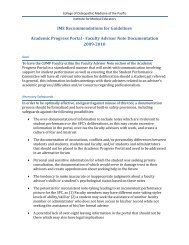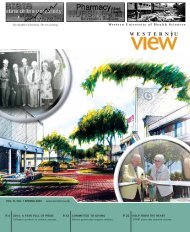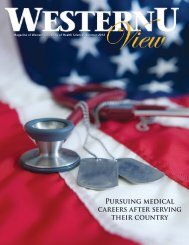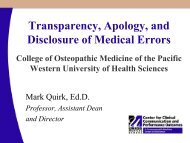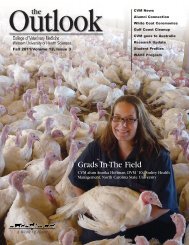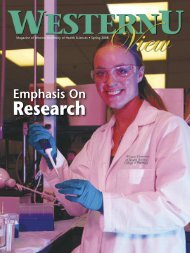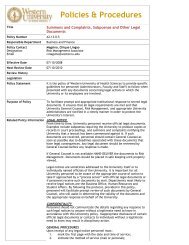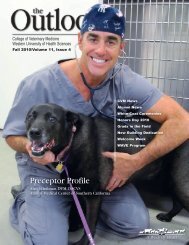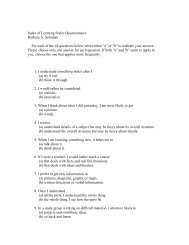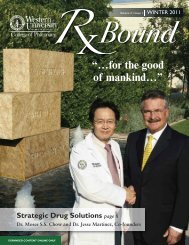Ou the tlook - Western University of Health Sciences
Ou the tlook - Western University of Health Sciences
Ou the tlook - Western University of Health Sciences
You also want an ePaper? Increase the reach of your titles
YUMPU automatically turns print PDFs into web optimized ePapers that Google loves.
C V M S t u d e n t P r o f i l e s - C l a s s o f 2 0 0 8♥Miranda NoseckI grew up in Tucson, Arizona and receiveda BS in zoology from Oregon State<strong>University</strong>. I have ridden horses all my lifeand began pursuing my veterinary dreamvolunteering at <strong>the</strong> non-pr<strong>of</strong>it Es<strong>the</strong>r HoneyAnimal Clinic in <strong>the</strong> Cook Islands. Myinterests include equine, marine,international, and rural medicine.Jeremy O’NeillI was born and raised in Red Bank,New Jersey. I graduated from VirginiaTech in 2001 with a BS in animalscience. Interests include small animalneurology and surgery. <strong>Ou</strong>tside <strong>of</strong>school I enjoy playing soccer andfishing on <strong>the</strong> Jersey Shore.I was raised in Canada, where I attendedUBC. Following graduation, I volunteered ata Vietnamese tropical disease hospital andwas consequently seduced by <strong>the</strong> Californiasun to research murine strain dependentretinopathies at USC. I am currentlykeeping an open and enthusiastic mind toa veterinary career in anything!Lucia PhamAfter graduating with a BS in animalscience from Iowa State <strong>University</strong>,I migrated from <strong>the</strong> midwest to <strong>the</strong> SanFrancisco area where I happily resideduntil gaining acceptance into <strong>Western</strong>U’sDVM program. My passion lies incompanion animals, but I am also eagerto explore <strong>the</strong> realm <strong>of</strong> public health.Alayson PhelpsBeth PintzowI am from Indiana, where I worked as aveterinary technician while pursuing mybachelor and master <strong>of</strong> science at Purdue.I have a dog and a cat, proud parents,and a wonderful longtime boyfriend.I am happy to be a student at <strong>Western</strong>U,where I can pursue my dream <strong>of</strong>becoming a small animal veterinarian.Mia ProvostI was raised in Texas and have livedand worked on a ranch for much <strong>of</strong>my life. My experiences on my family’sranch made me realize howimportant it was to care for animals.My interest is in large animals,especially beef cattle and horses.Born and raised in nor<strong>the</strong>rn California,I graduated from UC Santa Cruz with aBS degree in MCD biology. I have workedin a mixed animal practice as atechnician for four years and worked withmarine mammals for one year.My interests encompass small and marinemammals, immunology and surfing.Erika RoldanAfter receiving a degree in finance andaccounting, I began to volunteer with severalanimal rescue organizations.The perplexity<strong>of</strong> wild and stray animals threatened byhuman activity inspired me to address <strong>the</strong>seconcerns by redirecting my career. Followingmy education, I plan to work with ananimal rescue and rehabilitation center.Jennifer SchmidgallJulia SchoellenbachI am from San Francisco, Californiaoriginally, and did my undergraduatework at <strong>the</strong> <strong>University</strong> <strong>of</strong> California,Santa Cruz in biology. My initial interestswere in research, and much <strong>of</strong> myexperience is in equine research. Mycareer goals are up in <strong>the</strong> air, but I amleaning towards small animal practice.Danielle ShafferIn 2003, I received my BS in generalbiology from UC San Diego. I ampursuing a career in veterinarypathology and I would like to servein <strong>the</strong> area <strong>of</strong> diagnostics. I amhonored and blessed to be a part <strong>of</strong><strong>Western</strong>U Class <strong>of</strong> 2008.8
C V M F a c u l t y P r o f i l e sDR. AMY RAINES was raised on a small farm ineastern North Dakota. She completed her preveterinaryrequirements at North Dakota State<strong>University</strong>, <strong>the</strong>n <strong>of</strong>f to veterinary school inAmes, Iowa. After graduation in 1988, she tooka job in a mixed animal practice in NorthDakota and was <strong>the</strong> only veterinarian for a90-mile radius.This was her first encounter withProblem-Based Learning.When her husband,Dean, finished his term in <strong>the</strong> Air Force in 1989,<strong>the</strong>y moved to his home state <strong>of</strong> Texas, whereAmy Rainesshe became <strong>the</strong> second DVM in a small animalpractice in west Texas.The nearest referral hospital was 4 hours away inDallas, so if a pet needed a myelogram and a back surgery, she did it!It was in west Texas that Dr. Raines discovered ratites (ostriches, emus,rheas, cassowaries, kiwis). The exciting, and sometimes frustrating, thingabout working with <strong>the</strong>se birds was that no one knew anything.The best part <strong>of</strong> <strong>the</strong> experience was learning new things and <strong>the</strong>nsharing that knowledge with o<strong>the</strong>r veterinarians and producers throughfarm consultations, seminars, wet labs, book chapters and journalarticles. She was able to carry out and publish research on <strong>the</strong>pathogenicity <strong>of</strong> adenovirus in ostrich chicks in 1994. She also served aspresident <strong>of</strong> <strong>the</strong> Oklahoma Chapter <strong>of</strong> <strong>the</strong> American Ostrich Association(1995-1997),Vice President <strong>of</strong> <strong>the</strong> American Ostrich Association (1997),as well as President <strong>of</strong> <strong>the</strong> American Ostrich Association (1998-2003).Dr. Raines joined Banfield,The Pet Hospital, in 1997, and she becameChief <strong>of</strong> Staff and Hospital Director <strong>of</strong> <strong>the</strong> Norman, Oklahoma hospital.She served terms on <strong>the</strong> Board <strong>of</strong> Second Chance Animal Sanctuary asSecretary,Vice President, and President. She also volunteered time tomentor senior veterinary students from Oklahoma State <strong>University</strong> oneto two days a week when <strong>the</strong>y came to <strong>the</strong> sanctuary to performsurgeries on pets prior to adoption.In February <strong>of</strong> 2004, Dr. Raines accepted a position as Banfield MedicalDirector in Sou<strong>the</strong>rn California, and, in July <strong>of</strong> 2004, accepted a facultyposition with <strong>Western</strong>U College <strong>of</strong> Veterinary Medicine. Her dual rolehas been exciting and challenging and, as a practitioner who has workedwith many veterinarians and students over <strong>the</strong> years, she believes PBL is<strong>the</strong> way to learn. She shares her home with husband Dean, son Clancy,8, three bloodhounds and a cat. ♥DR. VICTORIA LEA VOITH joined <strong>the</strong>CVM faculty at <strong>Western</strong>U as aPr<strong>of</strong>essor <strong>of</strong> Animal Behavior inJuly, 2004. Dr.Voith is a graduate <strong>of</strong><strong>the</strong> Ohio State <strong>University</strong> (OSU)College <strong>of</strong> Veterinary Medicine.Her interest in <strong>the</strong> field <strong>of</strong> animalbehavior began while inveterinary school. Immediatelyafter graduation, she began formalstudies in <strong>the</strong> field <strong>of</strong> behaviorVictoria Voith and, with two o<strong>the</strong>r comparativepsychologists, founded an animal behavior clinic inColumbus, Ohio. She and her colleagues were convincedthat principles derived from <strong>the</strong> behavioral sciences couldbe applied to animal behavior problems–particularly thosethat, generally, were not being successfully treated byveterinarians. Although solving behavior problems wasinitially an adjunct to basic science pursuits, over <strong>the</strong> years<strong>the</strong> application <strong>of</strong> scientific principles to treat behaviorproblems <strong>of</strong> animals developed into a field <strong>of</strong> its own.Dr Voith is a charter diplomate <strong>of</strong> <strong>the</strong> American College <strong>of</strong>Veterinary Behaviorists.Dr.Voith received advanced training in psychology andanimal behavior in graduate schools at OSU (MS Ethology)and <strong>University</strong> <strong>of</strong> California, Davis (PhD Neuroanatomy/Behavior). She has taught animal behavior at severaluniversities and developed <strong>the</strong> Animal Behavior Clinic at<strong>the</strong> <strong>University</strong> <strong>of</strong> Pennsylvania School <strong>of</strong> VeterinaryMedicine.She has worked as a visiting scientist and clinical trialinvestigator for veterinary pharmaceutical companies.Immediately prior to coming to <strong>Western</strong>U, she served ascity veterinarian for Animal Services in <strong>the</strong> Environmental<strong>Health</strong> Department <strong>of</strong> <strong>the</strong> City <strong>of</strong> Albuquerque.Dr.Voith’s outside interests are search and rescue dogsand almost any horse-related activity. She also likes <strong>the</strong>water and is looking for people with whom to canoeand kayak. ♥♥INTERESTED IN SHAPING THE FUTURE OF THIS WONDERFUL PROFESSION?The <strong>Western</strong>U College <strong>of</strong> Veterinary Medicine Admissions and ScholasticStanding Committee (ASSC) is looking for veterinarians who are interested inserving on <strong>the</strong> committee for a 1-year (renewable) term, May 2005-06. <strong>Ou</strong>rpublic members are instrumental in bringing balance and insight into ourselection process, and we welcome those who would like to be considered for<strong>the</strong>se membership positions.Responsibilities include: meeting attendance and participation,candidate selection via file review and interview participation, and annualadmissions process evaluation.Time commitments include:Sept-Dec—Organizational meetings and some training (2-3 meetings, 3hrseach); some subcommittee/individual work on policy and procedureJan-Feb—File review (approximately 24hrs worth <strong>of</strong> work); interview training(1 meeting, 3-4hr)Feb—Interview weeks (4 full days or 8 half days)Mar-Aug—Organizational meeting for process evaluation(2 meetings; 2 hrs each)If you are interested in this membership position, please send letter <strong>of</strong> intent to:Lara Rasmussen, Chair ASSCCollege <strong>of</strong> Veterinary Medicine<strong>Western</strong> <strong>University</strong> <strong>of</strong> <strong>Health</strong> <strong>Sciences</strong>309 East Second Street, Pomona, CA 91766lmrasmussen@westernu.eduThank you for considering this opportunity.9
Always In <strong>Ou</strong>r Hearts:Stories from <strong>the</strong> WAVE Program“SUNDANCE”By Jaimie Sun Siegel, DVM ’07IT ALL STARTED WITH AN ARGUMENT–an argumentbetween a horse and a trainer. Who would haveever thought that, by being a “bad” and“untrainable” horse, my beloved Sundance wouldfind her way into my heart. But when that trainerdecided she was too difficult to work with, he gaveher away, free <strong>of</strong> charge, to an eager little girlwho turned out to be her perfect match. Over <strong>the</strong>next 12 years, Sundance grew old and I grew up;and we held on to each o<strong>the</strong>r every step <strong>of</strong> <strong>the</strong>way. When it was time to say good-bye to myoldest friend, I knew she had more to give.The WAVE program gave us that chance.♥The Willed Body Program for Veterinary Medicine, WAVETHE COLLEGE OF VETERINARY MEDICINE’S REVERENCE FOR LIFE COMMITMENT promises that animals will not be harmed for our teachingprograms. A key element <strong>of</strong> this commitment is <strong>the</strong> WAVE (Willed deceased Animals for Veterinary Education) Program, whichreaches out to animal owners like Jaimie to ask that <strong>the</strong>y consider donating <strong>the</strong>ir beloved pets’ remains to anatomy and clinical skillseducation at <strong>the</strong> College (The WAVE Program is modeled after <strong>the</strong> Human Willed Body Program at <strong>Western</strong>U). Over 500 deceasedanimals—including beloved friends like Sundance—have been donated to <strong>the</strong> College in <strong>the</strong> last two years. These special animalsare providing a greater quality <strong>of</strong> education to future generations <strong>of</strong> veterinarians.All donations to WAVE must be deceased due to age, serious illness or injury. An animal that has no owner to approve <strong>the</strong> donation<strong>of</strong> its remains will not be accepted. When you know <strong>the</strong> death <strong>of</strong> your beloved pet might be imminent, and you live within 40 miles<strong>of</strong> <strong>the</strong> College, please ask your veterinarian about donating to WAVE. Your veterinarian may contact Ms.Tami Jones at (909) 469-5597to make all arrangements.Always in <strong>Ou</strong>r Hearts: Stories from <strong>the</strong> WAVE Program will appear as regular feature in each issue <strong>of</strong> <strong>Ou</strong><strong>tlook</strong>.10
Excitement for third yearrotations buildingON FEBRUARY 16, 2005, a dozen small animal veterinariansfrom Los Angeles practices that will serve as sites for thirdyear student rotations in August 2005, came to campus tomeet <strong>the</strong> Class <strong>of</strong> 2007. It was an exciting day, as students hada chance to hear about <strong>the</strong> plans we have for <strong>the</strong>m and about<strong>the</strong> time <strong>the</strong>y will spend learning in practices. Groups <strong>of</strong>three students will spend two weeks each in a variety <strong>of</strong>practice disciplines. Four <strong>of</strong> <strong>the</strong> sixteen two-week rotationswill be completed in a small animal practice setting, one <strong>of</strong>those being anemergency clinicsetting. A Q&Asession between <strong>the</strong>veterinarians and <strong>the</strong>students waspreceded by a twohourlunch meetingwith <strong>the</strong> Clinical SiteCoordinators, toappraise <strong>the</strong>m <strong>of</strong> <strong>the</strong>goals and objectives that <strong>the</strong> College has for <strong>the</strong> students in<strong>the</strong>ir practices.The excitement from <strong>the</strong> CSCs almostmatches that <strong>of</strong> <strong>the</strong> students who are about to embark onthis adventure in <strong>the</strong>ir education. ♥ABOVE: Students in <strong>the</strong> Class <strong>of</strong> 2007 listening to presentations by third yearsmall animal rotation Clinical Site Coordinators. From right, Mike Kavanagh,Jennifer Nudleman, Kathleen Johnson, Hillary Hickam, Nicki Field, CiaraVollaro, Sybil Polanco, Pernilla Edstrom and Lisa Prior.LEFT: Dean Johnston (at podium) and Associate Dean Robert Mason (indoorway) introduce <strong>the</strong> Class <strong>of</strong> 2007 to third year small animal rotationClinical Site Coordinators.“I, who had had my heart full for hours, tookadvantage <strong>of</strong> an early moment <strong>of</strong> solitude, to cry in itvery bitterly. Suddenly a little hairy head thrust itselffrom behind my pillow into my face, rubbing its earsand nose against me in responsive agitation, anddrying <strong>the</strong> tears as <strong>the</strong>y came.”-- Elizabeth Barrett BrowningEach <strong>of</strong> us has experienced <strong>the</strong> comfort <strong>of</strong> an animalcompanion. They touch our hearts with <strong>the</strong>ir quiet, inquiringeyes and are contented to be our companions throughout all <strong>of</strong>our joys and sorrows.As a school <strong>of</strong> veterinary medicine, we have taken <strong>the</strong> health<strong>of</strong> all animals into our hearts in <strong>the</strong> same way that <strong>the</strong>se gentlefriends unquestioningly accept our human struggles. Theyhave become our work. Let our work become part <strong>of</strong> yourwork. A gift to <strong>the</strong> College <strong>of</strong> Veterinary Medicine will helpeducate <strong>the</strong> veterinarians who take such good care <strong>of</strong> ourgentle friends. Each gift makes a tremendous impact on oursmall, pace-setting community. Your confidence in and support<strong>of</strong> our mission speaks volumes.To make your gift, call (909) 469-5678.C V MC a l e n d a rFeb 28-Mar 4. . . . . . . . . . . . . . . . . . . . . . . . . . . . . . . . . . . Midterms WeekMar 7-11. . . . . . . . . . . . . . . . . . . . . . . . . . . . DVM Students’ Spring BreakMar 10-13. . . . AAVMC 2005 Annual Meeting & Iverson Bell SymposiumMar 16-18 . . . . . . . . . . . . . . . . . . . . . . . . . . . . . . . . . . CARES SymposiumMar 21-22 . . . . . . . . . . . . . . . . . . . . . . . . . . . . Faculty search interviewsMay 9-13. . . . . . . . . . . . . . . . . . . . . . . . . . . . . . . . . . . . . . . . . Finals WeekJun 2-4 . . . . The Healing Power <strong>of</strong> <strong>the</strong> Human-Animal Bond, Hollywood. . . . . . . . . . . . . . . . . . . . . . . . . . . . . (www.pawssf.org/conference/2005)Jul 7-9 . . . . . . . . . . . . . . . . . . . . . . . . . . 2nd International Conference on. . . . . . . . . . . . . . . . . . . Communication in Veterinary Medicine (ICCVM). . . . . . . . . . . . . . . . Blue Mountain Village Resort, Collingwood, OntarioJul 16-20 . . . . . . . . . . . . . . . . . . . . . Annual AVMA Meeting, MinneapolisAug 1. . . . . . . . . . . . . . . . . . . . . . First day <strong>of</strong> Orientation, Class <strong>of</strong> 2009. . . . . . . . . . . First day <strong>of</strong> Practice Management Course, Class <strong>of</strong> 2007Aug 6 . . . . . . . . <strong>University</strong> Convocation and CVM White Coat CeremonyAug 8. . . . . . . . . . . . . . . . . First day <strong>of</strong> class, 2005-2006 academic year♥11
MISSION STATEMENT:THE COLLEGE OF VETERINARY MEDICINE is committed toserving society and animals through <strong>the</strong> preparation <strong>of</strong>students for <strong>the</strong> practice <strong>of</strong> veterinary medicine, veterinarypublic health and/or veterinary research in an educational program<strong>of</strong> self-directed learning, reverence for life and clinical education through strategicpartnerships.The college sustains a vibrant diverse faculty by encouraging advancementthrough personal and pr<strong>of</strong>essional development and research.This creates an environment <strong>of</strong>competent, caring, ethical pr<strong>of</strong>essionals, where cooperative learning, public service, and scholarship can flourish. ♥Non-Pr<strong>of</strong>it Org.U.S. PostagePAIDPermit No. 465San Dimas, CA 91773College <strong>of</strong> Veterinary Medicine309 E. Second StreetPomona, California 91766-1854



